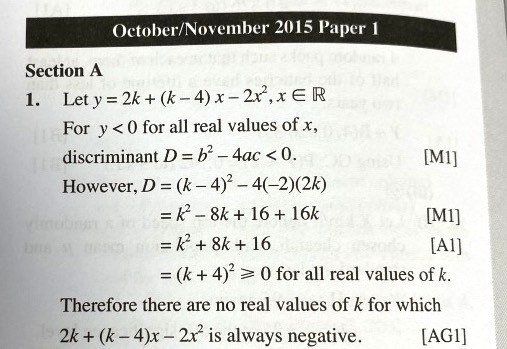QN's answer to QN's Junior College 1 H1 Maths Singapore question.
It was supposed to lead to b^2-4ac < 0. But how did (k+4)^2 ended up ≥ 0
We would actually like our discriminant
(k + 4)²
to be negative for the purposes of this question.
However, this can never happen, as (k + 4)² is naturally a non-negative expression for all real values of k.
(k + 4)²
to be negative for the purposes of this question.
However, this can never happen, as (k + 4)² is naturally a non-negative expression for all real values of k.
The answer scheme uses such an approach :
① For an always negative 2k + (k - 4)x - 2x²,
the discriminant < 0 (since it does not intersect the x-axis where y = 0 , which means there are no real roots of x)
② Now the discriminant = (k + 4)² .
If k is real, then k + 4 is also real.
So for all real values of k, (k + 4)² ≥ 0 (since the square of any real value is either 0 or positive) . So the discriminant will have to be ≥ 0
③ But in ① , we have already made the conclusion that the discriminant < 0 for an always negative 2k + (k - 4)x - 2x²
④ We can now conclude that there are no real values of k for which 2k + (k - 4)x - 2x² is always negative, since for all real values of k the discriminant is always positive or 0 (edited)
① For an always negative 2k + (k - 4)x - 2x²,
the discriminant < 0 (since it does not intersect the x-axis where y = 0 , which means there are no real roots of x)
② Now the discriminant = (k + 4)² .
If k is real, then k + 4 is also real.
So for all real values of k, (k + 4)² ≥ 0 (since the square of any real value is either 0 or positive) . So the discriminant will have to be ≥ 0
③ But in ① , we have already made the conclusion that the discriminant < 0 for an always negative 2k + (k - 4)x - 2x²
④ We can now conclude that there are no real values of k for which 2k + (k - 4)x - 2x² is always negative, since for all real values of k the discriminant is always positive or 0 (edited)
I remember one of my students asking me about this "discrepancy" because the logical sense seems weird. I had to do the explaining for my student because he was confused with the signages.
Do take note QN, that this answer scheme is published by the series publisher and not by Cambridge. So it really depends on what the markers there accept.
I see where the answer key is coming from. Thank you for the detailed explanation!
My approach was :
① For an always negative 2k + (k - 4)x - 2x²,
there is no intersection of the curve y = 2k + (k - 4)x - 2x² with the x-axis (where y = 0)
② This means that there are no real roots so discriminant < 0
③ Discriminant is found to be (k + 4)².
So for discriminant < 0, (k + 4)² < 0
④ Since (k + 4)² < 0, k is non-real.
Because for all real k, (k + 4)² ≥ 0.
So k cannot be real.
⑤ Therefore there are no real values of k for which 2k + (k - 4)x - 2x² is always negative.
① For an always negative 2k + (k - 4)x - 2x²,
there is no intersection of the curve y = 2k + (k - 4)x - 2x² with the x-axis (where y = 0)
② This means that there are no real roots so discriminant < 0
③ Discriminant is found to be (k + 4)².
So for discriminant < 0, (k + 4)² < 0
④ Since (k + 4)² < 0, k is non-real.
Because for all real k, (k + 4)² ≥ 0.
So k cannot be real.
⑤ Therefore there are no real values of k for which 2k + (k - 4)x - 2x² is always negative.




